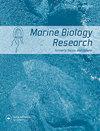Lakshadweep群岛与珊瑚礁相关的palaemonid虾群:特别关注Cuapetes-Clark,1919(十足目;Caridea),对新物种的描述和系统发育笔记
IF 1.2
4区 生物学
Q4 ECOLOGY
引用次数: 0
摘要
摘要:印度水域中与珊瑚礁相关的帕拉梅德虾群,尤其是在岛屿生态系统中,是研究最少的动物之一。在Lakshadweep群岛探险期间,根据从阿加蒂岛东部泻湖的死珊瑚和岩石海岸地区采集的标本(0.5-1.0 m) ,印度拉克沙德维普。该新种与秀丽隐杆线虫亲缘关系密切,具有明显的特征:喙部延伸至触角鳞片,腹齿排列在喙部宽无牙背侧下方,端子背棘较长,触角鞭毛节数较少,第一螯腿指略长于手掌,第二螯的螯,比柳和腕骨的总长度长,手掌膨胀。此外,还生成了线粒体基因细胞色素c氧化酶I(COI)、16S和核组蛋白3(H3)基因的部分序列,并与其他可用的Cuapetes物种进行了比较。系统发育分析有力地支持了我们的新发现,Cuapetes purushothamani sp.nov.,它与秀丽隐杆线虫有着密切的亲缘关系,具有较高的种间遗传差异(COI:19.2–19.9%;16S:12–12.8%;H3:3.1–3.9%)。http://zoobank.org/urn:lsid:zoobank.org:pub:1B5C9228-9D9F-430E-BF11-C6DC7510DF1B本文章由计算机程序翻译,如有差异,请以英文原文为准。
Reef-associated palaemonid shrimp fauna of Lakshadweep islands: special focus on Cuapetes Clark, 1919 (Decapoda; Caridea) with a description of new species and phylogenetic notes
ABSTRACT The reef-associated palaemonid shrimp fauna of Indian waters, especially in island ecosystems, is one of the least studied. During explorations at Lakshadweep Islands, Cuapetes elegans (Paulson 1875), C. grandis (Stimpson 1857) and a new species, Cuapetes purushothamani sp. nov., were recorded and illustrated based on the specimens collected from dead coral and rocky shore regions of eastern lagoon of Agatti Island (0.5–1.0 m), Lakshadweep, India. The new species shows close relation with C. elegans, possessing distinctive characteristics as indicated: rostrum extends as far as antennal scale, arrangement of ventral teeth below the wide edentulous dorsal part of rostrum, long dorsal spines of telson, a fewer number of segments in antennal flagellum, fingers of first chelated leg slightly longer than palm, chela of second cheliped longer than combined length of merus and carpus with inflated palm. In addition, the partial sequences of mitochondrial genes cytochrome c oxidase I (COI), 16S and nuclear Histone 3 (H3) gene were generated and compared with other available species of Cuapetes. The phylogenetic analyses strongly supported our new discovery, Cuapetes purushothamani sp. nov., which possesses a close relationship with C. elegans by having high interspecific genetic divergences (COI: 19.2–19.9%; 16S: 12–12.8%; H3: 3.1–3.9%). http://zoobank.org/urn:lsid:zoobank.org:pub:1B5C9228-9D9F-430E-BF11-C6DC7510DF1B
求助全文
通过发布文献求助,成功后即可免费获取论文全文。
去求助
来源期刊

Marine Biology Research
生物-海洋与淡水生物学
CiteScore
2.10
自引率
0.00%
发文量
55
审稿时长
6-12 weeks
期刊介绍:
Marine Biology Research (MBRJ) provides a worldwide forum for key information, ideas and discussion on all areas of marine biology and biological oceanography. Founded in 2005 as a merger of two Scandinavian journals, Sarsia and Ophelia, MBRJ is based today at the Institute of Marine Research, Bergen, Norway. The Journal’s scope encompasses basic and applied research from all oceans and marine habitats and on all marine organisms, the main criterium for acceptance being quality.
 求助内容:
求助内容: 应助结果提醒方式:
应助结果提醒方式:


